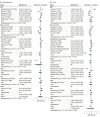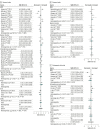Perturbations in Gut Microbiota Composition in Psychiatric Disorders: A Review and Meta-analysis
- PMID: 34524405
- PMCID: PMC8444066
- DOI: 10.1001/jamapsychiatry.2021.2573
Perturbations in Gut Microbiota Composition in Psychiatric Disorders: A Review and Meta-analysis
Erratum in
-
Add Open Access.JAMA Psychiatry. 2022 Jan 1;79(1):87. doi: 10.1001/jamapsychiatry.2021.3277. JAMA Psychiatry. 2022. PMID: 34730785 Free PMC article. No abstract available.
-
Error in Author Name.JAMA Psychiatry. 2022 Dec 1;79(12):1241. doi: 10.1001/jamapsychiatry.2022.3295. JAMA Psychiatry. 2022. PMID: 36197674 Free PMC article. No abstract available.
Abstract
Importance: Evidence of gut microbiota perturbations has accumulated for multiple psychiatric disorders, with microbiota signatures proposed as potential biomarkers. However, no attempts have been made to evaluate the specificity of these across the range of psychiatric conditions.
Objective: To conduct an umbrella and updated meta-analysis of gut microbiota alterations in general adult psychiatric populations and perform a within- and between-diagnostic comparison.
Data sources: Cochrane Library, PubMed, PsycINFO, and Embase were searched up to February 2, 2021, for systematic reviews, meta-analyses, and original evidence.
Study selection: A total of 59 case-control studies evaluating diversity or abundance of gut microbes in adult populations with major depressive disorder, bipolar disorder, psychosis and schizophrenia, anorexia nervosa, anxiety, obsessive compulsive disorder, posttraumatic stress disorder, or attention-deficit/hyperactivity disorder were included.
Data extraction and synthesis: Between-group comparisons of relative abundance of gut microbes and beta diversity indices were extracted and summarized qualitatively. Random-effects meta-analyses on standardized mean difference (SMD) were performed for alpha diversity indices.
Main outcomes and measures: Alpha and beta diversity and relative abundance of gut microbes.
Results: A total of 34 studies provided data and were included in alpha diversity meta-analyses (n = 1519 patients, n = 1429 control participants). Significant decrease in microbial richness in patients compared with control participants were found (observed species SMD = -0.26; 95% CI, -0.47 to -0.06; Chao1 SMD = -0.5; 95% CI, -0.79 to -0.21); however, this was consistently decreased only in bipolar disorder when individual diagnoses were examined. There was a small decrease in phylogenetic diversity (SMD = -0.24; 95% CI, -0.47 to -0.001) and no significant differences in Shannon and Simpson indices. Differences in beta diversity were consistently observed only for major depressive disorder and psychosis and schizophrenia. Regarding relative abundance, little evidence of disorder specificity was found. Instead, a transdiagnostic pattern of microbiota signatures was found. Depleted levels of Faecalibacterium and Coprococcus and enriched levels of Eggerthella were consistently shared between major depressive disorder, bipolar disorder, psychosis and schizophrenia, and anxiety, suggesting these disorders are characterized by a reduction of anti-inflammatory butyrate-producing bacteria, while pro-inflammatory genera are enriched. The confounding associations of region and medication were also evaluated.
Conclusions and relevance: This systematic review and meta-analysis found that gut microbiota perturbations were associated with a transdiagnostic pattern with a depletion of certain anti-inflammatory butyrate-producing bacteria and an enrichment of pro-inflammatory bacteria in patients with depression, bipolar disorder, schizophrenia, and anxiety.
Conflict of interest statement
Figures



References
-
- Phillips JGP. The treatment of melancholia by the lactic acid bacillus. J Mental Sci. 1910;56(234):422-430. doi:10.1192/bjp.56.234.422 - DOI
Publication types
MeSH terms
Grants and funding
- BBS/E/F/00044409/BB_/Biotechnology and Biological Sciences Research Council/United Kingdom
- DH_/Department of Health/United Kingdom
- BBS/E/F/000PR10353/BB_/Biotechnology and Biological Sciences Research Council/United Kingdom
- BBS/E/F/000PR10356/BB_/Biotechnology and Biological Sciences Research Council/United Kingdom
- MRC_/Medical Research Council/United Kingdom
LinkOut - more resources
Full Text Sources
Medical

